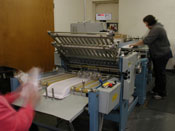 My education about the ugly duckling nature of bindery departments began as a new-hire apprentice when I watched the installation of a brand new 5 color press in our print shop. While the pressmen donned war paint and gleefully danced around their thoroughbred steed, I ran jobs on a folding machine so old the mechanic said the serial number pre-dated counting. Seriously. I was told I was lucky because I had not one, but TWO of these museum pieces to keep up with the five presses hurling work my way.
My education about the ugly duckling nature of bindery departments began as a new-hire apprentice when I watched the installation of a brand new 5 color press in our print shop. While the pressmen donned war paint and gleefully danced around their thoroughbred steed, I ran jobs on a folding machine so old the mechanic said the serial number pre-dated counting. Seriously. I was told I was lucky because I had not one, but TWO of these museum pieces to keep up with the five presses hurling work my way.
Did I feel neglected? Sure! Go ahead and call me a whiner, (there’s a space below for that) but how many times have you seen print shops showing off a gazillion dollars worth of shiny, gadget-filled press and pre-press equipment, yet using bindery equipment which Moses sold them.
In a recent article on MyPrintResource.com, Karen Hall says that “Despite all the talk about QR codes and marketing services, one of the most important weapons in your arsenal is still one of the most basic: your finishing department.” Amen to that!
In my experience, one vital thing that helped us retain the good customers (which in turn kept the new presses running) was the finishing department. For example, we had one key customer who required the gluing of easels to display cards, often in quantities of 50-100,000 or more, usually with just a couple of days to produce. Many shops could print it, but not all could finish it. We got that type of job frequently because our finishing department had a great system in place for getting it done fast, despite being very labor intense.
I’m sure every print shop has similar stories where finishing played a key role in getting or keeping an important job or customer. So why does there often seem to be such hesitancy to invest in the bindery and finishing department? There can be many answers to this question, but two come to mind, based on our thousands of conversations with printers through the years.
One contributing factor is that there are plenty of trade binderies to take on nearly any finishing job imaginable. The typical printer feels he will always be printing something, so it makes sense to invest in presses. Finishing requirements however, will change from job to job and that million-piece folding job this month may be the last folding job in the house for six months. So why risk investing in finishing equipment? Just send it to a trade bindery—let them handle all the specialized equipment investment. This makes sense.
A second factor is a resistance to doing Return on Investment homework. Why such resistance? Well, figuring ROI can be complicated—and uncomfortable.
• How much am I spending on outsourcing this work?
• How much is freight costing me?
• Have I lost any old customers because I can’t do it in-house?
• Have I lost potential new customers to competitors who can do it in-house?
• How much have I lost in rejected jobs?
• Do I even know my true hourly costs on this machine?
• How much will this upgrade to my folder add to the hourly cost?
• What’s the lifetime value of this potential new account?
Instead, it’s easier to look at cash flow, the money going out, and to just say no to the outflow. “Spend $2,000 for a $10,000 return within one year? Nah…I don’t want to spend the money this month. Besides, the bindery has been getting along just fine like this for 10 years.” This does not make sense; ROI should be a factor in all business decisions.
I’m fond of the old saying, “little hinges swing big doors.” As delivery times are measured in fewer and fewer hours, (forget about days and weeks!) and as average job quantities decline, the saying takes on more importance. Companies are forced to step back and take a big-picture look, to shave time and improve quality at every step of the way. Outsourcing for small quantities and quick turnaround is frequently not possible.
What is possible is the ability to make lots of small, ongoing, incremental changes—in all departments—which can add up to significant overall improvements. That 10% increase in folder productivity, perhaps inconsequential several years ago, can make a difference today in winning a bid. Fewer rejected jobs because of improved finishing quality can mean huge additional profits when you calculate the lifetime value of a customer. Combining those separate scoring, perfing and folding operations into one high-speed operation means faster turnaround and significantly higher profit margins.
Add up all the small improvements you can make throughout your bindery department. Then add them to the small changes you make in every other department. Together it makes for big improvements.
The nice thing about us ugly ducklings in the bindery is we don’t mind if the press room warriors get all the glory (usually.) Just don’t forget about us. Your customers and your competitors won’t let you.
All comments welcome...even from the pressroom!

